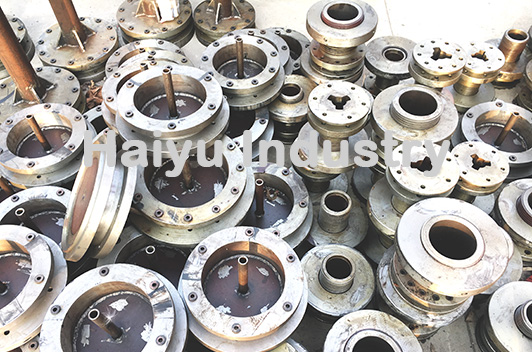The Stressing of Tendons of Concrete Poles
1. Placing of Reinforcement
Steel shall be free from all loose rust, grease, tar, paint, oil, mud, mill scale or other coating which would tend to destroy its bond with the concrete. All reinforcing bars shall be bent as shown on the Drawings and shall be placed accurately and be well secured by tie wiring or welding where permitted so that no displacement can occur during placing of concrete. The specified clear cover shall be maintained. Tie wire of at least 18 s.w.g. soft iron wire shall be bent inwards or cut off.

The fabricated cage shall be accurately positioned in the mould by the use of stainless steel studs welded to the reinforcing cage. Care shall be taken to ensure that the cage is correctly aligned and positioned in relation to the through-bolt holes, ferrules and the pole axis, and that the cage reinforcement is not spirally deformed or displaced.
Bending and splicing of reinforcing shall be carried out as required by AS 3600. Splices shall be of length sufficient to fully develop the capacity of the bars.
Reinforcing steel may be secured by welding. Welding shall be in accordance with AS 1554 Part 3 Welding of Reinforcing Steel and welding procedure shall be subject to approval by the Superintendent.
All prestressing tendons shall be accurately located and restrained in position. No welding will be permitted in close proximity to any prestressing tendon without suitable shielding.
Prestressing tendons where supplied in coils shall be of large enough diameter to be self straightening. Kinked or damaged tendons will not be permitted.
Prestressing steel shall not be welded and shall be flame cut only with the approval of the Superintendent.
2. Stressing of Tendons
2.1 General Requirements
The stressing operations shall be performed under the supervision of an experienced and competent person. Special precautions shall be taken when working with or near tendons which have been tensioned, or are in the process of being tensioned. The requirements as described in AS 3600 shall be complied with at all times.
All jacks used for prestressing shall be of the type applicable to the system adopted.
Before being used on the works all jacks and gauges shall be calibrated at an approved testing laboratory and the Superintendent shall be furnished with copies of the test certificates.
During the course of the prestressing operations the Superintendent may require that further calibration tests are carried out. These tests shall be carried out at a testing laboratory approved by the Superintendent and the cost of such testing will be borne by the Principal. In general, such further calibration will not be required unless jacking equipment has been roughly handled or damaged or tensioning operations show some anomalies.
2.2 Stressing Records
The Contractor shall keep full records of all tensioning operations including the following information, and shall furnish this to the Superintendent on request.
• date and time stressed
• cable identification number
• end stressed (post-tensioning only)
• jack and gauge identification number
• specified jacking force
• gauge reading corresponding to above with allowance for losses in jack and anchorage
• take up load
• calculated extension from take-up to final load
• actual extension
• draw-in at both anchorages
2.3 Stressing Procedure
Post-tensioning or release of load in pretensioned strands shall not proceed until the concrete has acquired the necessary compressive strength as required by the designer at transfer obtained from the mean of two cylinders tested.
Before starting the stressing operation, the Contractor shall calculate the amount of extension that should take place from the take-up load to the final load. Take-up load shall be sufficiently large so that no slack remains in pre-tensioned strands or wires and that the load in the cable in post- tensioned members has been transmitted to the dead-end anchorage.
All tensioning work shall be carried out in accordance with the requirements of AS 3600.
The prestress shall be transferred to the units in such a manner that the tendons are released gradually and preferably simultaneously.
2.4 Finishing Off
After the transfer of prestress, tendons shall be trimmed flush with the end of the units using power grinders.
After trimming, the ends of the tendon and the area immediately adjacent to the tendons shall be painted with two coats of an approved epoxy compound to provide a film thickness of at least 0.3 mm dry or 0.6 mm wet.
No painting shall be carried out until the concrete is dry, clean and brushed free of all loose dirt, and is in a satisfactory condition to receive the paint.

